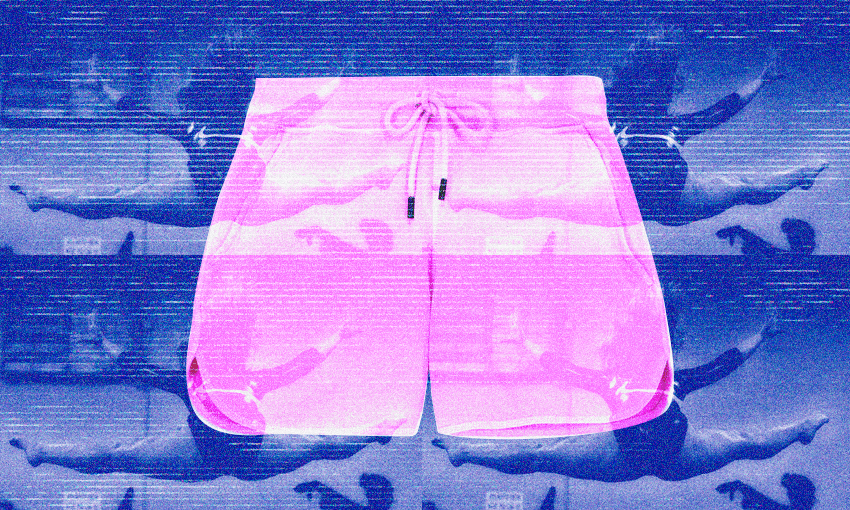With gymnasts now allowed to wear shorts while competing, Gabi Lardies wonders why other codes are still catching up.
Last week, Gymnastics New Zealand announced an overhaul of its competition attire rules. Now, people that are very good at jumping through the air while doing the splits are allowed to wear shorts and have their bra straps slip while they perform these miracles.
It’s a positive announcement, but it’s also bleak, because it’s pointed out that all this time things have not been the way they obviously should be. It is disappointing that in 2024 we do not live in utopia but merely a high-tech archaism, but here we are, letting gymnasts who are women wear shorts in competitions for the first time.
Shorts, a comfortable and practical garment allowing ease of movement by uncovering the knees, have been around for at least a couple of hundred years. They’ve gone from attire for little boys, to getting big pockets and being worn by militaries, to denim cut-offs which questioned authority, to tiny clingy hot pants in the 70s, then they got long and baggy again as the 90s rolled around. Since then anything goes unless you’ve been a woman pursuing certain athletic accolades.
Female gymnasts have had to wear leotards, AKA undies attached to a top. Often the top has long sleeves, but god – well, rules – forbade these athletes cover their legs. It’s true that it’s a sport where the body needs to be free to move in all sorts of contortions but Cathy Freeman proved in 2000 that a body in head to toe lycra can outrun competitors wearing next to nothing. It’s also true that many wanting to take part in gymnastics are going through puberty and while we all understand pubic hairs do not naturally stick to the confines of undies, many young women may die of embarrassment should their pubes be spotted. Meanwhile, the male gymnasts have been wearing unitards with long legs, and loose short shorts.
Ex-rhythmic gymnasts have told the Herald that the expectations went beyond bare legs, make-up and hair. Being skinny is expected, and judgemental comments are made by coaches and other gymnasts. It seems that for young women, participating in some sports comes with a set of requirements to look a certain way – some will love it, and others simply won’t take part. Having to put on a leotard, makeup, do your hair perfectly and be skinny can easily take the fun out of it.
It isn’t just what gymnasts have had to wear. The Football Ferns had to wear white shorts until their new kits for the world cup last year. Anyone who menstruates knows that is just dangerous (and therefore anxiety-inducing). The England Lawn Tennis and Croquet Club also let go of white bottoms at Wimbledon only in July last year, shortly after the Football Ferns’ announcement.
Following the whites in impracticality are the dresses. Short, tight dresses seen on netball courts. In 2022, Netball New Zealand issued a statement on uniforms to “encourage participation by removing overly strict/historic uniform barriers”. The statement allowed players to wear items for religious or cultural reasons such as hijab and taonga. It also allowed uniforms to be dresses, skirts, skorts or shorts and allowed long leggings, sports briefs and bike shorts to be worn underneath.
This is all very well and good, but uniforms aren’t provided by Netball NZ. While uniforms are allowed to be shorts, shorts may not always be made an option by the school or club. Or worse, a local authority may not approve – in 2009 (a while ago, mind you), a social netball team that wore shorts were asked not to by Netball Manawatu, despite Netball NZ saying the only clothing requirement in the rules was positional bibs.
Official ink on paper rules are just the tip of the iceberg when it comes to people’s, and especially women’s, appearances. Expectations are baked into the history of sport and culture. Bikinis are the most common uniform among female beach volleyball players, even though the International Volleyball Federation rules changed in 2012 to allow them to wear shorts or sleeved tops. Over a decade later players still choose bikinis to wear in often scorching sun because it’s been instilled into the sport. I would say that if you’re doing sports on solid ground the togs, togs, togs, undies rule applies but others say it’s easier to move in a bikini.
Wearing undies to play sports seems at odds with what we’ve got at our disposal. There’s many high-performance textiles that have moisture management systems, muscle compression panels, aerodynamic advantages and temperature control. If you’re wearing the smallest garment possible, you will get less of these benefits. It would appear to be much better to wear as much as possible, from head to toe. In fact, swimmers (the only sport where bikinis or undies might make sense) tried to make the most of technology with full-body tech suits, and those have since been banned. Why are other sporting codes so slow to evolve beyond uniforms that make women look more “lady-like”?
Missing out on the benefits of high-tech fabrics isn’t the biggest loss associated with small attire. The biggest loss is the people who would have loved to jump in the air while doing the splits but didn’t, because they didn’t want to do it in undies. Hopefully now they’ll have the chance.

